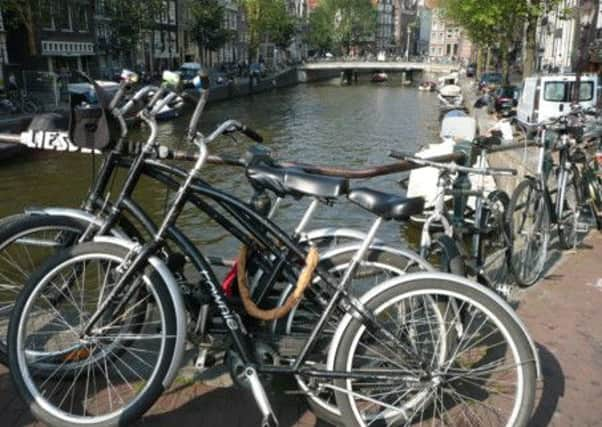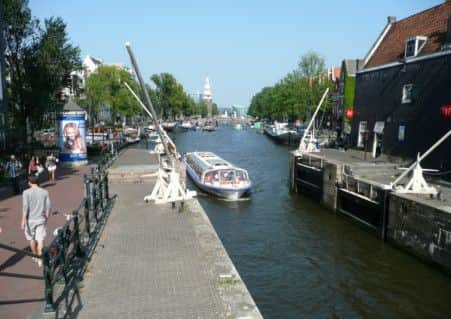Travel: A good reason to visit Holland this summer


In summer, the Dutch like to make the most of good weather by whiling away some time on a terrace and this is best done while enjoying a drink and a bite.
Among the favourites are a beer accompanied by a plate of bitterballen. These breaded savoury ragout balls are typically Dutch and are usually dipped in mustard. Other popular snacks are pieces of Dutch cheese and sausage or a bread basket with dips. So go local and try some bitterballen on a pleasant terrace!
The five best city beaches


Advertisement
Hide AdAdvertisement
Hide AdIt’s a huge trend in European cities: the city beach. After enjoying hectic urban life, these ‘beaches’ allow you to relax and enjoy without having to travel to the coast. We have found the best city beaches in Holland for you.
You can spend a wonderful day on a city beach. With summer weather and a range of tasty treats and drinks, these places are summer favourites! Several big cities in Holland boast city beaches.
1. Amsterdam: Strandzuid – Enjoy the sun the chic way! This luxury city beach offers 2,000 square metres of enjoyment for those who love lounging, good cocktails and great food. Relax on a lounge chair or compete in a game of beach volleyball. Unfortunately you cannot swim at Strandzuid so this is the ultimate location for enjoying the sun!
Address: Strandzuid. Europaplein 22, Amsterdam
2. Amsterdam: Strand West – The most relaxed city beach in Amsterdam. With its view of the IJ river and a relaxed atmosphere, this is the perfect city beach if you want to relax in care-free surroundings.
Advertisement
Hide AdAdvertisement
Hide AdThis is where you will find hammocks and beanbags and an alternative audience consisting mainly of students. An excellent DJ mans the turntables for those who love to dance.
Address: Strand West. Stavangerweg 900, Amsterdam
3. Amsterdam: IJburg beach – This is Amsterdam’s city beach for those who like swimming in natural water. A hippie-like mood that attracts young families and artistic Amsterdam locals. You will always find good music and an open fire here.
Address: Strand IJburg. Muiderlaan 1001, Amsterdam.
Hotel tip: Book a hotel in IJburg and Amsterdam from the other side. The small ferry takes you to the city in 10 minutes.
4. Rotterdam: Strand aan de Maas – Getting a tan whilst enjoying the view of Rotterdam’s skyline. This venue boasts a view of the Maas river and Rotterdam’s skyline. A great place for tanning, eating, dancing, playing beach volleyball and getting a massage. The excellent music ranges from jazzy to dance.
Address: Strand aan de Maas. Leuvehoofd, Rotterdam
Advertisement
Hide AdAdvertisement
Hide AdHotel tip: Hotel Bazar offers an eternal summer. Book this hotel and spend the night within walking distance of Strand aan de Maas. Book now starting at €73.
5. Utrecht: Strand Oog in Al – City beach with covered seating area.
Utrecht’s prime city beach is located at the northernmost tip of Oog in Al, where the Amsterdam Rhine Canal and Merwedekanaal join. Spend your day relaxing in the sun, enjoying some great food and drinks. Since it also has a covered seating area, you can even enjoy the beach when it’s raining.
Address: Strand Oog in Al, Kanaalweg 196, Utrecht
The Hague is full of art and culture
The Hague in summer has plenty to offer for art lovers! Visit the new Mauritshuis, go for a stroll on the antiques market, and admire the beautiful works at the free The Hague Sculpture exhibition.
Advertisement
Hide AdAdvertisement
Hide AdThe Hague, our beautiful government city by the sea, has everything for a wonderful summer holiday. This summer the Mauritshuis museum will reopen after renovations. It is a must see for art lovers!
The Mauritshuis is located in a beautiful 17th Century city palace. It houses the ‘Royal Cabinet’ of paintings, a unique collection of 800 works mainly from the Golden Age. From Frans Hals to Johannes Vermeer to Rembrandt – this is a must see for real art lovers.
You can also find plenty of art and antiques outside the museum as well. On the Lange Voorhout, across the road from the museum, a lovely antiques market welcomes visitors on Thursdays and Sundays in summer.
Here you’ll find antiques, curiosities, books and modern art. While away a few hours here in the shade of old lime trees and buy something old at a surprisingly affordable price to remember your holiday in Holland...
Advertisement
Hide AdAdvertisement
Hide AdOnce you have seen the antiques market, stroll along the Lange Voorhout to explore the sculptures. The Hague Sculpture transforms the Lange Voorhout into an open air museum where you can admire impressive, monumental sculptures free of charge.
Amsterdam Gay Pride is a huge celebration of devotion towards equality for the gay, lesbian and transgender communities, held in late July and early August every year.
The canal parade begins on 2 August after a week of parties and events leading up to this blowout weekend of festivities.
Amsterdam’s famous liberal-mindedness over the years has encouraged a welcoming and safe environment for gays, lesbians and transgenders to both visit and live in.
Advertisement
Hide AdAdvertisement
Hide AdThe city’s gay rights history, from early-day tolerance to modern Mayoral celebrants has meant Amsterdam has always been at the world forefront in striving for equality for the gay community.
As a result Amsterdam Gay Pride remains one of the biggest and best celebrations of its kind around the globe. It traditionally takes place around the first weekend of August every year, drawing more than 350,000 gay and straight participants and visitors to stay and play in Amsterdam.
The city is a rainbow of events in gay and straight venues alike, from dance parties to film festivals, sporting events, culture and more.
Liberation route launched
In 2014 the world commemorates the 70th anniversaries of significant military manouevres during the liberation of Europe including the D-Day Landings at Normandy and Operation Market Garden in Holland.
Advertisement
Hide AdAdvertisement
Hide AdOn June 6 the Dutch initiative Liberation Route Europe was officially launched in Arromanches, France and became a transnational route. Jeanine Hennis-Plasschaert, Dutch Minister of Defence officially opened the commemoration event at Arromanches, which was also attended by King Willem-Alexander and Queen Maxima and Prime Minister Rutte.
The Liberation Route Europe is a continuously growing, international remembrance trail that connects important milestones from modern European history and reaches across national borders. The Liberation Route Europe began in 2008 as a regional initiative in the province of Gelderland, Holland.
The route forms a link between the main regions along the Western Allie Forces’ advance from southern England, to the beaches of Normandy, Paris, the Belgian Ardennes, Brabant, Arnhem, Nijmegen, the Hürtgen Forest and on to Berlin.
The route then continues to the Polish city of Gdansk, where a democratic revolution for overcoming the division of Europe was launched nearly two generations later.
Advertisement
Hide AdAdvertisement
Hide AdIt focuses on the liberation of continental Europe from the Nationalist Socialist occupation, and specifically, the long-lasting consequences of Second World War.
The Liberation Route Europe provides the chance to discover and experience the route that the Allied Forces took during the final phase of Second World War. The trail connects locations and places of remembrance to stories.
Stories from soldiers and citizens, told from different perspectives. The aim of route is to make this core part of European history more visible and accessible for visitors all over the world.
Victoria Van Krieken, Director, Liberation Route Europe said at the launch: “The international expansion of the route, which started as a project in 2008 in the Netherlands, is no coincidence.
Advertisement
Hide AdAdvertisement
Hide Ad“On this historical day, we are standing at a historical location. Arromanches is part of the Liberation Route Europe. As a foundation we think it is very important to show the world that no-one can take freedom for granted.
“We have paid a high price for a free Europe. With the Liberation Route Europe we can connect historical locations and keep the history alive.”
Now people from all over the world can experience the route through a new, interactive website and route app in five languages – English, Dutch, German, Polish and French.
In 2007, an intern at the Airborne Museum ‘Hartenstein’ in Oosterbeek, Holland, received the task of intensifying the relationships between the many war museums in the Arnhem-Nijmegen area and South Veluwe region, and the regions´ various battlefields.
Advertisement
Hide AdAdvertisement
Hide AdHis report made its way to the Regional Tourist Office Arnhem Nijmegen (RBTKAN), and it was used in 2008 to establish the Liberation Route in Holland. The first audio spots and audio stories were opened in this area; one that played a pivotal role in the history of the allied advance.
The audio spots consist of boulders marking the locations of the events that took place during the war. Visitors can listen to audio stories from the liberationroute.com website or using a free phone 0900 number.
These are personal stories about what that happened at those specific locations during the liberation. More audio spots soon followed and in 2011, the Liberation Route Europe Foundation was established for the further development of the Liberation Route.